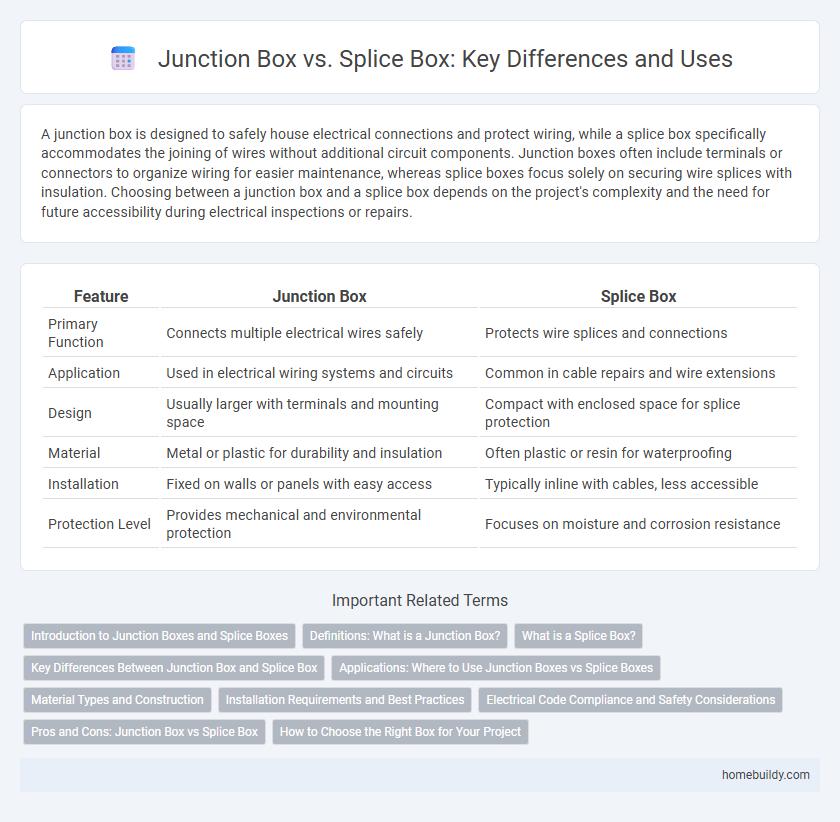A junction box is designed to safely house electrical connections and protect wiring, while a splice box specifically accommodates the joining of wires without additional circuit components. Junction boxes often include terminals or connectors to organize wiring for easier maintenance, whereas splice boxes focus solely on securing wire splices with insulation. Choosing between a junction box and a splice box depends on the project's complexity and the need for future accessibility during electrical inspections or repairs.
Table of Comparison
| Feature | Junction Box | Splice Box |
|---|---|---|
| Primary Function | Connects multiple electrical wires safely | Protects wire splices and connections |
| Application | Used in electrical wiring systems and circuits | Common in cable repairs and wire extensions |
| Design | Usually larger with terminals and mounting space | Compact with enclosed space for splice protection |
| Material | Metal or plastic for durability and insulation | Often plastic or resin for waterproofing |
| Installation | Fixed on walls or panels with easy access | Typically inline with cables, less accessible |
| Protection Level | Provides mechanical and environmental protection | Focuses on moisture and corrosion resistance |
Introduction to Junction Boxes and Splice Boxes
Junction boxes serve as protective enclosures for electrical connections, ensuring safety and organization within wiring systems. Splice boxes specifically house wire splices, facilitating secure connections without the need for additional enclosures. Understanding the distinction between junction boxes and splice boxes is crucial for proper electrical installation and maintenance.
Definitions: What is a Junction Box?
A junction box is an enclosure designed to protect and organize electrical wire connections, ensuring safety and preventing short circuits. It serves as a central point where multiple cables are joined and routed to various devices or circuits. Unlike splice boxes, junction boxes provide a more structured and secure housing for electrical connections, meeting regulatory standards for installation.
What is a Splice Box?
A splice box is an enclosure designed specifically to protect and organize wire splices, ensuring secure electrical connections and preventing exposure to environmental elements. Unlike a junction box, which serves as a broader connection point for electrical cables and devices, a splice box focuses solely on housing and safeguarding splice points. This specialized function helps maintain system integrity and simplifies troubleshooting in complex wiring setups.
Key Differences Between Junction Box and Splice Box
A junction box serves as a protective enclosure for connecting multiple electrical wires, ensuring safety and organization in wiring systems, while a splice box specifically houses wire splices to maintain secure, insulated connections. Junction boxes are typically larger, accommodating multiple circuits and often include mounting points for switches or outlets. In contrast, splice boxes are more compact, designed solely for joining wires and preventing exposure to environmental elements or accidental contact.
Applications: Where to Use Junction Boxes vs Splice Boxes
Junction boxes are ideal for protecting electrical connections in residential, commercial, and industrial wiring systems where multiple cables converge or branch off, ensuring secure housing for splices and terminals. Splice boxes are specifically designed for joining or extending wires in confined spaces, commonly used in underground or outdoor applications where moisture resistance and compact size are crucial. Selecting between junction boxes and splice boxes depends on project requirements, environmental conditions, and the complexity of the electrical network.
Material Types and Construction
Junction boxes are typically constructed from durable materials such as PVC, metal (steel or aluminum), or fiberglass, designed to provide robust protection against environmental factors and mechanical impacts. Splice boxes often utilize similar materials but prioritize ease of access and insulation for wire connections, often featuring thermoplastic or rubber gaskets to enhance moisture resistance. The construction of junction boxes emphasizes structural integrity and mounting options, whereas splice boxes focus on securing and isolating electrical splices within a compact enclosure.
Installation Requirements and Best Practices
Junction boxes require secure mounting and proper grounding to ensure electrical safety and code compliance, while splice boxes often demand additional insulation and protective measures to safeguard wire connections. Best installation practices for junction boxes emphasize accessibility for future maintenance and adherence to local electrical codes, whereas splice boxes should be installed in a dry, concealed location to prevent exposure to environmental factors. Both types necessitate using appropriate connector fittings and ensuring all wire splices are neatly organized and insulated to minimize risk of short circuits or fire hazards.
Electrical Code Compliance and Safety Considerations
Junction boxes meet strict Electrical Code requirements by providing secure enclosures for wire connections to prevent accidental contact and contain sparks or heat in the event of a fault, enhancing overall safety. In contrast, splice boxes, often used for simpler wire splices, may lack the robust containment and standardized approval that junction boxes offer, posing higher risks of electrical hazards and code violations. Ensuring compliance with NEC (National Electrical Code) standards, junction boxes are essential for durable, safe electrical installations in residential and commercial settings.
Pros and Cons: Junction Box vs Splice Box
A junction box provides organized connectivity and protection for multiple electrical cables, offering easier access for maintenance and expansion, but it tends to be bulkier and more expensive than a splice box. Splice boxes are more compact and cost-effective, ideal for simple wire splices, yet they lack the structural support and enhanced safety features found in junction boxes. Choosing between a junction box and splice box depends on the complexity of the wiring system, space constraints, and the need for future accessibility.
How to Choose the Right Box for Your Project
Choosing the right box between a junction box and a splice box depends on the project's wiring requirements and space constraints. Junction boxes typically provide more room for connecting multiple wires and are ideal for housing complex electrical connections securely, while splice boxes are designed primarily for protecting wire splices in more confined spaces. Assess the number of connections, accessibility needs, and installation environment to ensure safety and code compliance in your electrical project.
Junction box vs Splice box Infographic

 homebuildy.com
homebuildy.com